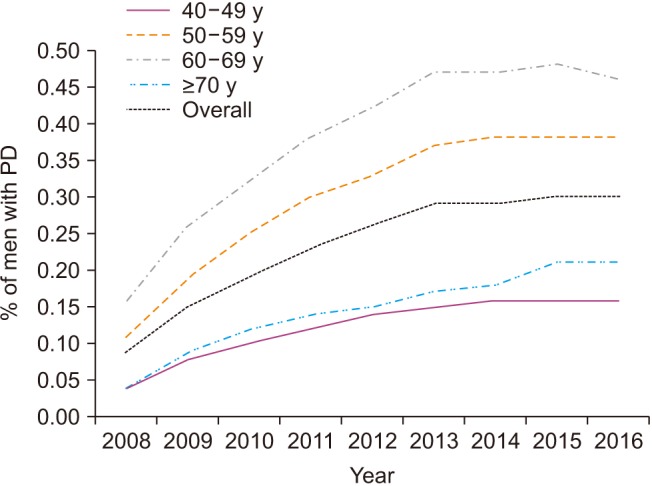World J Mens Health.
2019 May;37(2):234-239. 10.5534/wjmh.180073.
The Impact of Clostridium Histolyticum Collagenase on the Prevalence and Management of Peyronie's Disease in the United States
- Affiliations
-
- 1Department of Urology, Stanford University, Stanford, CA, USA. eisenberg@stanford.edu
- 2Department of Obstetrics and Gynecology, Stanford University, Stanford, CA, USA.
- KMID: 2443239
- DOI: http://doi.org/10.5534/wjmh.180073
Abstract
- PURPOSE
We evaluated the impact of collagenase clostridium histolyticum (CCH) on rates of diagnosis, treatment, and corporal rupture in Peyronie's disease (PD). We examined the impact of CCH on cost of PD treatment.
MATERIALS AND METHODS
We extracted data on PD diagnosis (ICD-9 607.95 and ICD-10 N48.6), corporal rupture (ICD-9 959.13 and ICD-10 S39.840A), CCH use (J0775), penile injections (CPT 54200), and corporal rupture repair from 2008 to 2016 in men over 40 years old using the Clinformatics® Data Mart Database (3.7 to 4.9 million males). We analyzed for prevalence of PD, rates of PD treatments, cost associated with treatment, and rates of corporal rupture and repair by year.
RESULTS
The prevalence of PD was 0.29% in 2013 and did not increase after CCH entered the market in 2014. An average of 2.52% of men with PD received treatment before CCH, compared with 3.75% after (p<0.0001). Penile injection rates increased (1.34% vs. 2.61%, p<0.0001), while rates of surgical treatments decreased between these periods. There was no change in rate of corporal rupture in men with PD before (0.024%) and after (0.024%) CCH. Overall, only 20.0% of corporal ruptures were repaired. After CCH entered practice, a significant increase in cost occurred (p=0.013).
CONCLUSIONS
The prevalence of men with PD did not change after CCH. However, more men with PD received treatment due to an increase in penile injections. The cost of treating PD increased after CCH became available. The overall prevalence of corporal rupture did not change after CCH entered the market.
MeSH Terms
Figure
Reference
-
1. Nehra A, Alterowitz R, Culkin DJ, Faraday MM, Hakim LS, Heidelbaugh JJ, et al. Peyronie's disease: AUA Guideline. J Urol. 2015; 194:745–753. PMID: 26066402.
Article2. Dibenedetti DB, Nguyen D, Zografos L, Ziemiecki R, Zhou X. A population-based study of Peyronie's disease: prevalence and treatment patterns in the United States. Adv Urol. 2011; 2011:282503. PMID: 22110491.
Article3. Arafa M, Eid H, El-Badry A, Ezz-Eldine K, Shamloul R. The prevalence of Peyronie's disease in diabetic patients with erectile dysfunction. Int J Impot Res. 2006; 19:213–217. PMID: 16915304.
Article4. El-Sakka AI. Prevalence of Peyronie's disease among patients with erectile dysfunction. Eur Urol. 2006; 49:564–569. PMID: 16386353.
Article5. Nelson CJ, Mulhall JP. Psychological impact of Peyronie's disease: a review. J Sex Med. 2013; 10:653–660. PMID: 23153101.
Article6. Rehman J, Benet A, Melman A. Use of intralesional verapamil to dissolve Peyronie's disease plaque: a long-term single-blind study. Urology. 1998; 51:620–626. PMID: 9586617.
Article7. Shirazi M, Haghpanah AR, Badiee M, Afrasiabi MA, Haghpanah S. Effect of intralesional verapamil for treatment of Peyronie's disease: a randomized single-blind, placebo-controlled study. Int Urol Nephrol. 2009; 41:467–471. PMID: 19199072.
Article8. Gelbard M, Goldstein I, Hellstrom WJ, McMahon CG, Smith T, Tursi J, et al. Clinical efficacy, safety and tolerability of collagenase clostridium histolyticum for the treatment of Peyronie disease in 2 large double-blind, randomized, placebo controlled phase 3 studies. J Urol. 2013; 190:199–207. PMID: 23376148.
Article9. Yafi FA, Anaissie J, Zurawin J, Sikka SC, Hellstrom WJ. Results of SMSNA survey regarding complications following intralesional injection therapy with collagenase clostridium histolyticum for Peyronie's disease. J Sex Med. 2016; 13:684–689. PMID: 27045265.
Article10. Beilan JA, Wallen JJ, Baumgarten AS, Morgan KN, Parker JL, Carrion RE. Intralesional injection of collagenase clostridium histolyticum may increase the risk of late-onset penile fracture. Sex Med Rev. 2018; 6:272–278. PMID: 28923562.
Article11. Luo J, Seeger JD, Donneyong M, Gagne JJ, Avorn J, Kesselheim AS. Effect of generic competition on Atorvastatin prescribing and patients' out-of-pocket spending. JAMA Intern Med. 2016; 176:1317–1323. PMID: 27367749.
Article12. Maraka S, Mwangi R, McCoy RG, Yao X, Sangaralingham LR, Singh Ospina NM, et al. Thyroid hormone treatment among pregnant women with subclinical hypothyroidism: US national assessment. BMJ. 2017; 356:i6865. PMID: 28122781.
Article13. Desai RJ, Gagne JJ, Lii J, Liu J, Friedman S, Kim SC. Comparative risk of incident venous thromboembolism in patients with inflammatory bowel disease initiating tumour necrosis factor-α inhibitors or nonbiologic agents: a cohort study. CMAJ. 2017; 189:E1438–E1447. PMID: 29180383.
Article14. Pollack A. Injections to treat an embarrassing ailment win U.S. approval [Internet]. New York: The New York Times;c2017. cited 2017 Sep 22. Available from: https://www.nytimes.com/2013/12/07/business/fda-approves-treatment-forcurved-penis.html.15. Weinberg AE, Eisenberg M, Patel CJ, Chertow GM, Leppert JT. Diabetes severity, metabolic syndrome, and the risk of erectile dysfunction. J Sex Med. 2013; 10:3102–3109. PMID: 24010555.
Article16. Sullivan J, Moskovic D, Nelson C, Levine L, Mulhall J. Peyronie's disease: urologist's knowledge base and practice patterns. Andrology. 2015; 3:260–264. PMID: 25331235.
Article17. LaRochelle JC, Levine LA. A survey of primary-care physicians and urologists regarding Peyronie's disease. J Sex Med. 2007; 4:1167–1173. PMID: 17627727.
- Full Text Links
- Actions
-
Cited
- CITED
-
- Close
- Share
- Similar articles
-
- Collagenase Clostridium Histolyticum in the Treatment of Peyronie's Disease: Review of a Minimally Invasive Treatment Option
- Intralesional collagenase Clostridium histolyticum vs. verapamil injections in males with Peyronie’s Disease: A prospective, matched-pair, non-blinded, randomised clinical study comparing clinical outcomes and patient satisfaction rates
- How Atypical Penile Curvature Influence Clinical Outcomes in Patients with Peyronie's Disease Receiving Collagenase Clostridium Histolyticum Therapy?
- Collagenase Clostridium Histolyticum Injection for Dupuytren Contracture: 2-Year Follow-up
- Two cases of Peyronie's disease treated by auto-dermal graft technique


